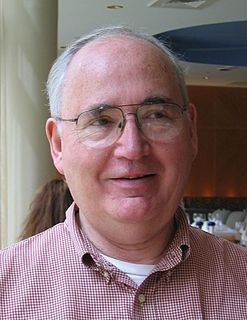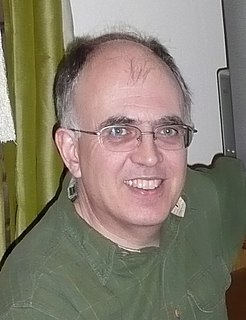Related Research Articles
In mathematics, a continuous function is a function such that a continuous variation of the argument induces a continuous variation of the value of the function. This means that there are no abrupt changes in value, known as discontinuities. More precisely, a function is continuous if arbitrarily small changes in its value can be assured by restricting to sufficiently small changes of its argument. A discontinuous function is a function that is not continuous. Up until the 19th century, mathematicians largely relied on intuitive notions of continuity, and considered only continuous functions. The epsilon–delta definition of a limit was introduced to formalize the definition of continuity.

Discrete mathematics is the study of mathematical structures that can be considered "discrete" rather than "continuous". Objects studied in discrete mathematics include integers, graphs, and statements in logic. By contrast, discrete mathematics excludes topics in "continuous mathematics" such as real numbers, calculus or Euclidean geometry. Discrete objects can often be enumerated by integers; more formally, discrete mathematics has been characterized as the branch of mathematics dealing with countable sets. However, there is no exact definition of the term "discrete mathematics".

Dana Stewart Scott is an American logician who is the emeritus Hillman University Professor of Computer Science, Philosophy, and Mathematical Logic at Carnegie Mellon University; he is now retired and lives in Berkeley, California. His work on automata theory earned him the Turing Award in 1976, while his collaborative work with Christopher Strachey in the 1970s laid the foundations of modern approaches to the semantics of programming languages. He has worked also on modal logic, topology, and category theory.
Domain theory is a branch of mathematics that studies special kinds of partially ordered sets (posets) commonly called domains. Consequently, domain theory can be considered as a branch of order theory. The field has major applications in computer science, where it is used to specify denotational semantics, especially for functional programming languages. Domain theory formalizes the intuitive ideas of approximation and convergence in a very general way and is closely related to topology.
Order theory is a branch of mathematics that investigates the intuitive notion of order using binary relations. It provides a formal framework for describing statements such as "this is less than that" or "this precedes that". This article introduces the field and provides basic definitions. A list of order-theoretic terms can be found in the order theory glossary.
This is a glossary of some terms used in various branches of mathematics that are related to the fields of order, lattice, and domain theory. Note that there is a structured list of order topics available as well. Other helpful resources might be the following overview articles:
In mathematics, a closure operator on a set S is a function from the power set of S to itself that satisfies the following conditions for all sets
In the branch of mathematics known as topology, the specialization (or canonical) preorder is a natural preorder on the set of the points of a topological space. For most spaces that are considered in practice, namely for all those that satisfy the T0 separation axiom, this preorder is even a partial order (called the specialization order). On the other hand, for T1 spaces the order becomes trivial and is of little interest.
In mathematics, the phrase complete partial order is variously used to refer to at least three similar, but distinct, classes of partially ordered sets, characterized by particular completeness properties. Complete partial orders play a central role in theoretical computer science: in denotational semantics and domain theory.
In computer science and mathematical logic, a function type is the type of a variable or parameter to which a function has or can be assigned, or an argument or result type of a higher-order function taking or returning a function.
Sergei Petrovich Novikov is a Soviet and Russian mathematician, noted for work in both algebraic topology and soliton theory. In 1970, he won the Fields Medal.
In mathematics, especially in order theory, a complete Heyting algebra is a Heyting algebra that is complete as a lattice. Complete Heyting algebras are the objects of three different categories; the category CHey, the category Loc of locales, and its opposite, the category Frm of frames. Although these three categories contain the same objects, they differ in their morphisms, and thus get distinct names. Only the morphisms of CHey are homomorphisms of complete Heyting algebras.
In mathematics, given two partially ordered sets P and Q, a function f: P → Q between them is Scott-continuous if it preserves all directed suprema. That is, for every directed subset D of P with supremum in P, its image has a supremum in Q, and that supremum is the image of the supremum of D, i.e. , where is the directed join. When is the poset of truth values, i.e. Sierpiński space, then Scott-continuous functions are characteristic functions of open sets, and thus Sierpiński space is the classifying space for open sets.
In mathematics, the upper topology on a partially ordered set X is the coarsest topology in which the closure of a singleton is the order section for each If is a partial order, the upper topology is the least order consistent topology in which all open sets are up-sets. However, not all up-sets must necessarily be open sets. The lower topology induced by the preorder is defined similarly in terms of the down-sets. The preorder inducing the upper topology is its specialization preorder, but the specialization preorder of the lower topology is opposite to the inducing preorder.
In mathematics, a structure is a set endowed with some additional features on the set. Often, the additional features are attached or related to the set, so as to provide it with some additional meaning or significance.
In algebraic geometry, a generic pointP of an algebraic variety X is, roughly speaking, a point at which all generic properties are true, a generic property being a property which is true for almost every point.

Steve Vickers is a British mathematician and computer scientist. In the early 1980s, he wrote ROM firmware and manuals for three home computers, the Sinclair ZX81 and ZX Spectrum and the Jupiter Ace. The latter was produced by Jupiter Cantab, a short-lived company Vickers formed together with Richard Altwasser, after the two had left Sinclair Research. Since the late 1980s, Vickers has been an academic in the field of geometric logic, writing over 30 papers in scholarly journals on mathematical aspects of computer science. His book Topology via Logic has been influential over a range of fields. In October 2018, he retired as senior lecturer at the University of Birmingham. As announced on his university homepage, he continues to supervise PhD students at the university and focus on his research.
In applied mathematics, topological based data analysis (TDA) is an approach to the analysis of datasets using techniques from topology. Extraction of information from datasets that are high-dimensional, incomplete and noisy is generally challenging. TDA provides a general framework to analyze such data in a manner that is insensitive to the particular metric chosen and provides dimensionality reduction and robustness to noise. Beyond this, it inherits functoriality, a fundamental concept of modern mathematics, from its topological nature, which allows it to adapt to new mathematical tools.
Computable topology is a discipline in mathematics that studies the topological and algebraic structure of computation. Computable topology is not to be confused with algorithmic or computational topology, which studies the application of computation to topology.
References
- G. Gierz, K. H. Hofmann, K. Keimel, J. D. Lawson, M. Mislove, D. S. Scott (2003), Continuous Lattices and Domains, Encyclopedia of Mathematics and its Applications, Cambridge University Press. ISBN 0-521-80338-1